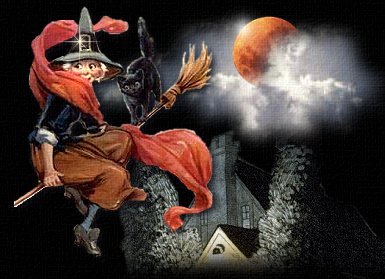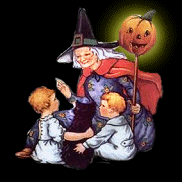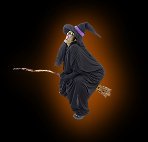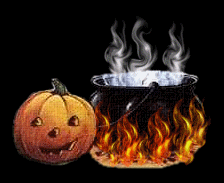|

Angels, Spirits and Devils

A
Halloween Sermon
by the Rev. Lee Woofenden
Bridgewater,
Massachusetts, October 26, 1997

Readings:
1
Samuel 16:14-23 David drives the evil spirit out of Saul with music
Matthew 4:1-11 Jesus tempted by the Devil
Apocalypse Explained #323c.12 "Harp" means affirmation of
truth
Whenever
the evil spirit from God came upon Saul, David would take his harp and
play it with his hand. Then relief would come to Saul; he would feel
better, and the evil spirit would leave him. (1 Samuel 16:23)
 Fortunately,
unlike King Saul, we did not have any evil spirits present at
our Halloween party last night. In fact, we were in very good
spirits--even though we did have a few strange and scary characters
lurking around. . . . Fortunately,
unlike King Saul, we did not have any evil spirits present at
our Halloween party last night. In fact, we were in very good
spirits--even though we did have a few strange and scary characters
lurking around. . . .
 At
Halloween, our thoughts turn to supernatural, nocturnal, and generally
unearthly beings and powers. It is hard to see all the costumes of
ghosts and angels without thinking at least a little about other realms
of existence besides th At
Halloween, our thoughts turn to supernatural, nocturnal, and generally
unearthly beings and powers. It is hard to see all the costumes of
ghosts and angels without thinking at least a little about other realms
of existence besides th e
physical. The costumes are expressions of our spirits--of our
imaginations. Most of the time these particular areas of our imagination
are confined to story books. But on Halloween our imaginings--both the
noble and the terrifying--appear in full dress. e
physical. The costumes are expressions of our spirits--of our
imaginations. Most of the time these particular areas of our imagination
are confined to story books. But on Halloween our imaginings--both the
noble and the terrifying--appear in full dress.
 In
our culture, Halloween has become a children's festival. It is a far cry
from the genuinely scary All Hallow's Eve of earlier centuries, when
real witches and evil spirits were believed to be out and about, and
people shut themselves indoors for fear. We In
our culture, Halloween has become a children's festival. It is a far cry
from the genuinely scary All Hallow's Eve of earlier centuries, when
real witches and evil spirits were believed to be out and about, and
people shut themselves indoors for fear. We  live
in a less superstitious time. Science and the intellectual revolution
have banished the fear of spirits from most people's minds. Many deny
their existence altogether, and look upon those who do believe in of
angels and spirits as irrational and backward. They see belief in
spiritual entities--including God--to be an unnecessary vestige of our
past. live
in a less superstitious time. Science and the intellectual revolution
have banished the fear of spirits from most people's minds. Many deny
their existence altogether, and look upon those who do believe in of
angels and spirits as irrational and backward. They see belief in
spiritual entities--including God--to be an unnecessary vestige of our
past.
For
several decades, it looked as though this materialistic view might
prevail in our culture. But the recent resurgence of interest in angels,
spirits, near death experiences, and other manifestations of the
spiritual world is evidence that the human mind does not stop at
material things, but has a deep-seated need to reach beyond the physical
to the spiritual. For many, the materialistic world view has been tried
and found wanting. While pure science apart from spirit has brought us
many material comforts and advances, it has failed to address the
deepest questions and needs of the human spirit.
Throughout
our societal flirtation with materialism Halloween has, if anything,
become even more popular. Despite the inevitable commercialization, it
remains a regular reminder, ingrained in our culture, of the reality of
the world that lies beyond and within the physical world. I suspect its
popularity is a result of our need for spiritual balance in an age that
has been far too unbalanced in the direction of non-spiritual pursuits.
Even
some of the parts of Halloween that many of us find objectionable may
serve a use. When I see some of the ghoulish and sometimes sickening
faces that appear at this time of year on the TV screen and in various
store displays and advertisements, I want to turn away to avoid having
such images imprinted on my mind. Yet this is one of the few times when
our culture explicitly recognizes the reality of evil. Our reaction to
ghoulish Halloween masks is the same as our reaction to the ghoulish
face of evil: we want to avoid it, both as individuals and as a culture.
Usually,
avoiding evil is a good idea. In fact, Swedenborg sums up our spiritual
rebirth as a process of avoiding evils as sins and doing good things
because they come from the Lord. So there is a sense in which we should
avoid evil and its trappings.
The
problem is that we cannot always avoid evil because evil is not only
around us . . . it is also within us. If we "avoid
evil" by refusing to face up to the wrong and evil parts of
ourselves, then we are not avoiding evil at all. We are doing just the
opposite: we are allowing it to continue working unopposed in our lives.
As
a culture, we have not only flirted with materialism; we have also
flirted with denying evil's existence. A popular social theory of our
day holds that nothing and nobody is evil; murderers, thieves, rapists,
and other criminals are merely responding to a faulty environment--poor
social conditions, lack of proper care as children, poverty,
malnutrition, and so on. There is some truth to this. It is true
that even people who are basically good-hearted will often fall into
damaging and destructive ways of living if this is all (or practically
all) that they have seen as they have grown up. We do need to
address social issues of poverty, injustice, and all the evils that
follow in their wake.
The
flaw with social theories that deny the existence of evil in human
motives and actions is that they fail to account for how poverty and
injustice began. If there were no evil in the human mind and spirit,
where did it all start? Where did the first wars come from? Where did
the longstanding gap between rich and poor come from? Where did theft,
murder, and lying come from? If there were no human evil, how could
children ever be exposed to unloving and harmful environments in the
first place?
Evil
is making a comeback in our society. I don't mean that our society is
committing more evil acts; I mean that social theories and religions
that deny the existence of evil have been tried and found wanting. There
is renewed acceptance of the idea that evil is very real, and is working
in the human mind and heart.
One
danger in this new acceptance is that we might descend back into
superstitious fear of evil and be no better off than when we cringed
behind locked doors on Halloween for fear that witches would cast evil
spells on us. However, I believe that for the most part, that kind of
fear of demonic spirits has been too thoroughly exorcized from our
consciousness to pose a real threat.
A
greater threat is that we might descend back into a black and white view
of the world, in which some people are good and others are evil--and we,
of course, are the good ones, while "they" are the evil ones.
In some quarters, along with a rising recognition of evil there is a
rising tide of intolerance and bigotry that must be countered if we are
to move forward rather than backward in our return to a belief in the
reality of spiritual good and evil.
The
teachings of our church about the spiritual world form a very good
counterbalance to that kind of unthinking return to a black and white
world of good and evil people. It is not that we don't see black and
white in spiritual matters. Rather, it is that our position here on
earth happens to be in the gray area between black and white.
Let
me explain. Swedenborg says that the spiritual world is made up of three
regions: heaven, hell, and a in-between region called the World of
Spirits. Heaven is the closest we human beings come to pure goodness.
People who go to heaven and become angels have set aside their evil
desires and accepted goodness and truth from God as the focus of their
lives. They are not perfect--and sometimes they do experience the
downward tug of pride and selfishness. But their lives are devoted to
loving God and loving their neighbor.
Hell
is just the opposite: it is the closest we human beings come to pure
evil. People who become devils or satans in hell have put aside any good
motives or pangs of conscience in favor of an existence exclusively
devoted to their own pleasure at the expense of others. Even evil
spirits do not manage to be purely evil; if they did, they would
annihilate themselves. The only reason they can continue to live is
that, closed off and protected in the deepest levels of their souls,
there is the infant existence of an angel of light. It has never had the
chance to mature, but that deeply buried presence of goodness is what
keeps evil spirits alive despite all their destructive motives and
actions.
So
far, we could make a good case for a black and white universe--good on
one side and evil on the other. But we would have to ignore the third
region of the spiritual world: the World of Spirits. This region between
heaven and hell is where good and evil meet . . . and
blend into countless shades of gray. This is also where our earth with
its human population has its primary contact with the spiritual world.
As long as we are here on earth, not a single one of us is entirely an
angel of light nor entirely a devil of darkness. We are all shades of
gray, moving either toward the light or toward the darkness.
Whatever
measures we as a society may need to take to restrain criminals from
harming others, there is no excuse for making the spiritual judgment
that any person is irredeemably evil. As long as people are still
alive here on earth, there is hope that they may choose a heavenly path,
no matter what their past has been. Our job is not to condemn--and thus
use the force of our minds to push people closer to hell--but to reach
out to them in an attempt to separate them from the evil they may be
involved in. We may have to put them in prison, but our motive for doing
so should be to protect the innocent and to make it more likely that
criminals will reconsider the course of their lives. Our motive should not
be to pay them back for what they did. Our intentions should always be
for the good of everyone involved--even if we may sometimes have to
express those intentions in seemingly harsh ways with some people and in
some situations.
So
far, we have been talking mostly about the negative side of spiritual
reality--about evil and hellish spirits and their influence on us here
on earth. But even though ghosts and ghouls are very popular at
Halloween, so are angels, princesses, Indian chiefs, and other
characters who represent what is good and heavenly in the human spirit.
In
our readings from Samuel, evil spirits assail King Saul. In Matthew, it
is Jesus that they attack. We have all had our struggles with evil and
depressing thoughts and desires. We will continue to have them as long
as we are living and growing spiritually here on earth. But the Lord
does not leave us hopeless. He sends his angels--and good spirits of the
earthly human variety--to help us in our struggles with evil.
I
was particularly touched by the reading about King Saul and David
because of a recent experience Patty and I have had with little Caleb.
We read in Samuel, "Whenever the evil spirit from God came upon
Saul, David would take his harp and play it with his hand. Then relief
would come to Saul; he would feel better, and the evil spirit would
leave him." In Apocalypse Revealed #276, Swedenborg tells us
that a harp corresponds to affirmation of the Lord, which evil spirits
cannot endure--and this is why David caused the evil spirit to depart
from Saul by playing his harp.
Caleb
has had a cold lately. Like most babies, when he feels sick and has a
hard time breathing through his nose, he doesn't sleep well. None of our
usual ways of getting him to sleep had been working. We finally
discovered (once again) that if we sing to him when he is tired
and crying, he will settle down and go to sleep. I like to think that,
just as with Saul when David played music for him, when the evil spirits
that hover around and contribute to Caleb's misery in the midst of his
cold hear the singing and feel our love for him, they can't stand it, so
they go away and leave the baby in peace.
This
is the kind of peace that we can all have if we affirm our belief in the
Lord by turning to the Lord in prayer when we are being assailed by evil
spirits who push us toward depression and despair, or toward doing and
saying things that we know are wrong and hurtful. If, in the words of
Jesus, we "worship the Lord our God, and serve him only," then
after our time of trial the devil will depart from us, and angels will
come and lovingly attend to us.




Music: Dimensions
© 1999 Bruce DeBoer


Floating
Ghost Script
courtesy of:

Special
DHTML Effects
Courtesy of

|